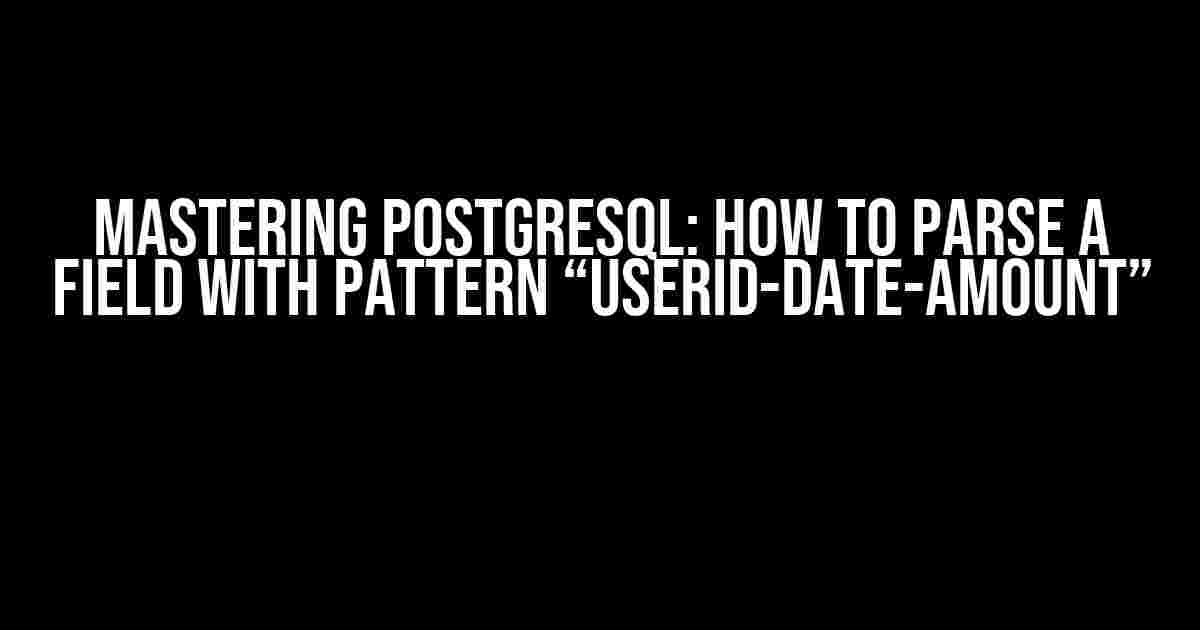Are you tired of dealing with complex data formatting issues in your PostgreSQL database? Do you have a field that follows a specific pattern, such as “userid-date-amount”, and you’re unsure how to extract and manipulate the individual components? Fear not, dear reader, for today we’ll embark on a journey to tackle this challenge head-on!
What is Pattern Matching in PostgreSQL?
Before we dive into the solution, let’s take a step back and understand the concept of pattern matching in PostgreSQL. Pattern matching allows you to extract specific parts of a string or data based on a predefined pattern. In our case, we want to parse a field with the pattern “userid-date-amount” to retrieve the individual components.
Why is Pattern Matching Important?
Pattern matching is crucial in various scenarios, such as:
- Data migration and integration: When dealing with data from different sources, pattern matching helps to normalize and standardize the data.
- Data analysis and reporting: By extracting specific components, you can create informative reports and perform meaningful analysis.
- Data quality and validation: Pattern matching enables you to verify and cleanse your data, ensuring data consistency and accuracy.
Understanding the Pattern “userid-date-amount”
Let’s dissect the pattern “userid-date-amount” to understand the components we need to extract:
userid-date-amount | | | | | amount (numeric value) | date (date in YYYY-MM-DD format) userid (alphanumeric string)
Breaking Down the Pattern
We can identify three main components:
- userid: An alphanumeric string representing the user ID.
- date: A date in the format YYYY-MM-DD.
- amount: A numeric value representing the amount.
Using Regular Expressions to Parse the Field
Regular expressions (regex) are a powerful tool for pattern matching in PostgreSQL. We’ll use the `regexp_match` function to extract the individual components.
First, let’s create a sample table and insert some data:
CREATE TABLE parse_example (
id SERIAL PRIMARY KEY,
field_text VARCHAR(50)
);
INSERT INTO parse_example (field_text)
VALUES
('user123-2022-01-01-10.50'),
('user456-2022-02-15-20.00'),
('user789-2022-03-20-30.25');
Now, let’s use the `regexp_match` function to extract the components:
SELECT
field_text,
regexp_match(field_text, '^([^‐-]+)‐([0-9]{4}‐[0-9]{2}‐[0-9]{2})‐([0-9]+\\.[0-9]+)$') AS matched
FROM
parse_example;
This will return an array with three elements, representing the userid, date, and amount:
| field_text | matched |
|---|---|
| user123-2022-01-01-10.50 | {user123,2022-01-01,10.50} |
| user456-2022-02-15-20.00 | {user456,2022-02-15,20.00} |
| user789-2022-03-20-30.25 | {user789,2022-03-20,30.25} |
Understanding the Regex Pattern
Let’s break down the regex pattern used in the `regexp_match` function:
^([^‐-]+)‐([0-9]{4}‐[0-9]{2}‐[0-9]{2})‐([0-9]+\\.[0-9]+)$
This pattern consists of three capturing groups:
- `^([^‐-]+)`: Matches the userid at the start of the string, capturing one or more characters that are not hyphens or dashes.
- `([0-9]{4}‐[0-9]{2}‐[0-9]{2})`: Matches the date in the format YYYY-MM-DD, capturing four digits, two digits, and two digits, respectively, separated by hyphens.
- `([0-9]+\\.[0-9]+)`): Matches the amount, capturing one or more digits, followed by a decimal point, and one or more digits.
Splitting the Field into Separate Columns
Now that we’ve extracted the individual components, let’s split the field into separate columns:
SELECT
field_text,
(regexp_match(field_text, '^([^‐-]+)‐([0-9]{4}‐[0-9]{2}‐[0-9]{2})‐([0-9]+\\.[0-9]+)$'))[1] AS userid,
(regexp_match(field_text, '^([^‐-]+)‐([0-9]{4}‐[0-9]{2}‐[0-9]{2})‐([0-9]+\\.[0-9]+)$'))[2] AS date,
(regexp_match(field_text, '^([^‐-]+)‐([0-9]{4}‐[0-9]{2}‐[0-9]{2})‐([0-9]+\\.[0-9]+)$'))[3] AS amount
FROM
parse_example;
This will return the following result:
| field_text | userid | date | amount |
|---|---|---|---|
| user123-2022-01-01-10.50 | user123 | 2022-01-01 | 10.50 |
| user456-2022-02-15-20.00 | user456 | 2022-02-15 | 20.00 |
| user789-2022-03-20-30.25 | user789 | 2022-03-20 | 30.25 |
Conclusion
And there you have it! By using regular expressions and the `regexp_match` function, we’ve successfully parsed a field with the pattern “userid-date-amount” and extracted the individual components. This technique can be applied to various scenarios where data follows a specific pattern, making it easier to work with and analyze.
Remember, practice makes perfect. Experiment with different regular expressions and patterns to become a master of data parsing in PostgreSQL!
Final Thoughts
Before we part ways, keep in mind:
- Regular expressions can be complex and may require fine-tuning for specific patterns.
- Data quality and consistency are crucial for accurate pattern matching.
- PostgreSQL offers a wide range of functions and techniques for data manipulation and analysis.
Stay curious, stay creative, and happy parsing!
Frequently Asked Question
Are you stuck on parsing a field with a pattern “userid-date-amount” in PostgreSQL? Worry not, we’ve got you covered!
Q: How do I parse a field with a pattern “userid-date-amount” in PostgreSQL?
You can use the `regexp_match` function to parse the field. For example: `SELECT regexp_match(‘userid-2022-01-01-10.00’, ‘([^-]+)-([:-]+)-([:.]+)’) AS match;` This will return an array of three elements: `{userid, 2022-01-01, 10.00}`.
Q: How do I extract each part of the pattern separately?
You can use the `regexp_split_to_table` function to split the field into separate columns. For example: `SELECT * FROM regexp_split_to_table(‘userid-2022-01-01-10.00’, ‘-‘) AS t(col);` This will return a table with four columns: `userid`, `2022-01-01`, `10`, and `00`.
Q: How do I convert the date part to a valid PostgreSQL date type?
You can use the `to_date` function to convert the date part to a valid PostgreSQL date type. For example: `SELECT to_date(regexp_match(‘userid-2022-01-01-10.00’, ‘([:-]+)’)[1], ‘YYYY-MM-DD’) AS date_part;` This will return a valid date type `2022-01-01`.
Q: How do I convert the amount part to a valid PostgreSQL numeric type?
You can use the `to_number` function to convert the amount part to a valid PostgreSQL numeric type. For example: `SELECT to_number(regexp_match(‘userid-2022-01-01-10.00’, ‘([:.]+)’)[1], ‘99.99’) AS amount_part;` This will return a valid numeric type `10.00`.
Q: Can I use this approach for parsing large datasets?
While this approach works for small datasets, it may not be efficient for large datasets. For large datasets, it’s recommended to use a more optimized approach, such as using a separate table with a composite primary key or using a specialized parsing library.
